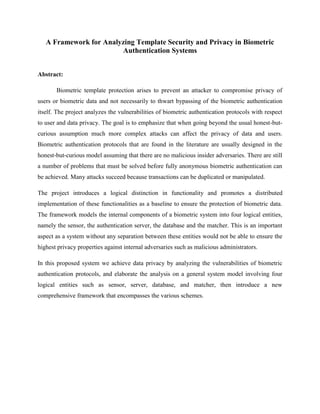
Framework for analyzing template security and privacy in biometric authentication systems
- 1. A Framework for Analyzing Template Security and Privacy in Biometric Authentication Systems Abstract: Biometric template protection arises to prevent an attacker to compromise privacy of users or biometric data and not necessarily to thwart bypassing of the biometric authentication itself. The project analyzes the vulnerabilities of biometric authentication protocols with respect to user and data privacy. The goal is to emphasize that when going beyond the usual honest-but- curious assumption much more complex attacks can affect the privacy of data and users. Biometric authentication protocols that are found in the literature are usually designed in the honest-but-curious model assuming that there are no malicious insider adversaries. There are still a number of problems that must be solved before fully anonymous biometric authentication can be achieved. Many attacks succeed because transactions can be duplicated or manipulated. The project introduces a logical distinction in functionality and promotes a distributed implementation of these functionalities as a baseline to ensure the protection of biometric data. The framework models the internal components of a biometric system into four logical entities, namely the sensor, the authentication server, the database and the matcher. This is an important aspect as a system without any separation between these entities would not be able to ensure the highest privacy properties against internal adversaries such as malicious administrators. In this proposed system we achieve data privacy by analyzing the vulnerabilities of biometric authentication protocols, and elaborate the analysis on a general system model involving four logical entities such as sensor, server, database, and matcher, then introduce a new comprehensive framework that encompasses the various schemes.
- 2. EXISTING SYSTEM: In this existing system , we analyze the vulnerabilities of biometric authentication protocols with respect to user and data privacy. The goal of an adversary in such context is not to bypass the authentication but to learn information either on biometric data or on users that are in the system. We elaborate our analysis on a general system model involving four logical entities (sensor, server, database, and matcher), and we focus on internal adversaries to encompass the situation where one or a combination of these entities would be malicious. Our goal is to emphasize that when going beyond the usual honest-but-curious assumption much more complex attacks can affect the privacy of data and users. Disadvantages: 1) Some attacks have a low complexity, e.g., linear in the size of the references. 2) That the objective of this work is to demonstrate that existing solutions suffer from certain weaknesses. 3) The vulnerabilities of biometric authentication protocols with respect to user and data privacy. 4) The existing method show very less performance in authentication. PROPOSED SYSTEM : In this proposed system ,we introduce a new comprehensive framework that encompasses the various schemes we want to look at. It presents a system model in which each internal entity or combination of entities is a potential attacker.
- 3. Different attack goals are considered and resulting requirements on data flows are discussed. On the other hand, we develop different generic attacks. We follow a blackbox approach in which we consider components that perform operations on biometric data but where only the input/output behavior is analyzed. These attack strategies are exhibited on recent schemes such as the distributed protocol of Bringer et al. (ACISP 2007), which is based on the Goldwasser–Micali cryptosystem, the related protocol of Barbosa et al. (ACISP 2008), which uses the Paillier cryptosystem, and the scheme of Stoianov (SPIE 2010), that features the Blum–Goldwasser cryptosystem. All these schemes have been developed in the honest-but-curious adversary model and show potential weaknesses when considered in our malicious insider attack model. Advantages: 1) Biometric authentication protocols that are found in the literature are usually designed in the honest-but-curious model assuming that there are no malicious insider adversaries. 2) Such analysis is extremely relevant in the context of independent database providers. Much attention was given to an authentication server attacker, which is a central and powerful entity in our model. 3) To prevent the attacks that were presented, stronger enforcement of the protocol design is needed: many attacks succeed because transactions can be duplicated or manipulated. 4) This is the case for the decomposed reference attack, which particularly targets bit-wise or feature-wise encryptions. The motivation for applying encryption on the feature level is to benefit from the homomorphic properties of the applied cryptosystem. As a consequence,better cryptographic primitives are needed that allow performing computations on encrypted data without allowing to attack individual features.
- 4. System Specification: Hardware Requirements: Processor : Pentium –III Speed : 1.1 GHz RAM : 256 MB(min) Hard Disk : 20 GB Floppy Drive : 1.44 MB Key Board : Standard Windows Keyboard Mouse : Two or Three Button Mouse Monitor : SVGA Software Requirements Operating system : Windows 07& XP Front End : Visual Studio 2008, ASP.net, C# Backend : SQL Server 2005